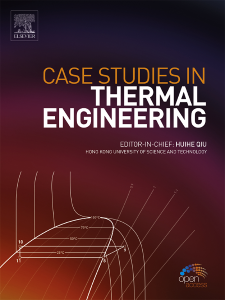Heat transfer enhancement using ternary hybrid nanofluid for cross-viscosity model with intelligent Levenberg-Marquardt neural networks approach incorporating entropy generation
IF 6.4
2区 工程技术
Q1 THERMODYNAMICS
引用次数: 0
Abstract
Thermal heat transfer analysis of trihybrid nanofluids using an intelligent Levenberg-Marquardt neural network (ANN-LMA) approach, with a focus on entropy generation, has been conducted. The flow equations were modeled in Cartesian coordinates and simplified using dimensionless variables. Partial differential equations were converted into ordinary differential equations through appropriate similarity transformations. These ordinary differential equations were then solved using the finite element method applied to a data set evaluated from (ANN-LMA) approach. This dataset can be input into MATLAB to generate predicted solutions for flow patterns. The ANN-LMA technique was employed to evaluate the efficiency of heat transfer characteristics for nanofluids in various scenarios. Incorporating carbon nanotubes (both single-wall (SWCNT) and multi-wall (MWCNT)) along with iron oxide in water, the study demonstrates their effectiveness in enhancing heat transfer. These nanofluids have broad industrial applications, such as in coolant enhancement, cancer therapy, and solar radiation management, and show promising results. This study specifically examines the flow properties of water-based CNT cross-trihybrid nanofluids over a convectively heated surface, leveraging their unique characteristics. Improvements in heat transfer are achieved through the introduction of dissipative heat, thermal radiation, and external heat sources or sinks. The performance of the computational solver was assessed using error histograms, regression analyses, and Mean Squared Error (MSE) results. The physical significance of the designed factors is graphically depicted and discussed in detail. It was found that radiative heat increases surface heat energy through substantial accumulation, thereby enhancing heat transfer properties, while dissipative heat, due to Joule dissipation and other external sources, significantly raises the fluid temperature.
利用包含熵生成的智能 Levenberg-Marquardt 神经网络方法,使用三元混合纳米流体提高交叉粘度模型的传热性能
采用智能 Levenberg-Marquardt 神经网络(ANN-LMA)方法对三混合纳米流体进行了传热分析,重点关注熵的产生。流动方程以直角坐标建模,并使用无量纲变量进行简化。通过适当的相似变换,将偏微分方程转换为常微分方程。然后使用有限元法对这些常微分方程进行求解,并将其应用于通过(ANN-LMA)方法评估的数据集。该数据集可输入 MATLAB,生成流动模式的预测解。ANN-LMA 技术用于评估各种情况下纳米流体的传热特性效率。将碳纳米管(包括单壁碳纳米管(SWCNT)和多壁碳纳米管(MWCNT))与氧化铁一起加入水中,这项研究证明了它们在增强传热方面的有效性。这些纳米流体具有广泛的工业应用前景,如用于增强冷却剂、癌症治疗和太阳辐射管理,并显示出良好的效果。本研究利用水基碳纳米管交叉三元杂化纳米流体的独特特性,专门研究了它们在对流加热表面上的流动特性。通过引入散热、热辐射和外部热源或散热器,实现了热传递的改善。计算求解器的性能通过误差直方图、回归分析和平均平方误差 (MSE) 结果进行了评估。对设计因素的物理意义进行了详细的图示和讨论。研究发现,辐射热通过大量积累增加了表面热能,从而提高了传热性能,而焦耳耗散和其他外部热源导致的耗散热则显著提高了流体温度。
本文章由计算机程序翻译,如有差异,请以英文原文为准。
求助全文
约1分钟内获得全文
求助全文
来源期刊

Case Studies in Thermal Engineering
Chemical Engineering-Fluid Flow and Transfer Processes
CiteScore
8.60
自引率
11.80%
发文量
812
审稿时长
76 days
期刊介绍:
Case Studies in Thermal Engineering provides a forum for the rapid publication of short, structured Case Studies in Thermal Engineering and related Short Communications. It provides an essential compendium of case studies for researchers and practitioners in the field of thermal engineering and others who are interested in aspects of thermal engineering cases that could affect other engineering processes. The journal not only publishes new and novel case studies, but also provides a forum for the publication of high quality descriptions of classic thermal engineering problems. The scope of the journal includes case studies of thermal engineering problems in components, devices and systems using existing experimental and numerical techniques in the areas of mechanical, aerospace, chemical, medical, thermal management for electronics, heat exchangers, regeneration, solar thermal energy, thermal storage, building energy conservation, and power generation. Case studies of thermal problems in other areas will also be considered.
 求助内容:
求助内容: 应助结果提醒方式:
应助结果提醒方式:


